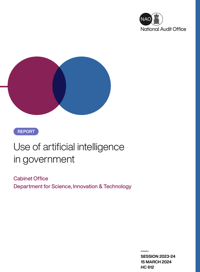NAO: Government needs to tackle AI barriers to realise benefits
 A new report from the National Audit Office - Use of artificial intelligence in government - into the government’s use of AI warns that achieving benefits will require not just adoption of new technology but also significant changes in business process and workforce changes.
A new report from the National Audit Office - Use of artificial intelligence in government - into the government’s use of AI warns that achieving benefits will require not just adoption of new technology but also significant changes in business process and workforce changes.
The NAO report, Use of artificial intelligence in government, surveyed 89 government bodies including the main government departments, and the majority of arm’s-length bodies with annual operational expenditure over approximately £83 million.
The report found that AI presents the government with opportunities to transform public services, potentially delivering billions of pounds in productivity savings.
Nearly three quarters (70%) of government bodies responding to the survey are piloting or planning AI, with typically four use cases being explored per body - and over a third of respondents (37%) have already deployed AI. Examples include departments using AI to analyse digital images, to automate routine checks as part of application processes, and to draft or summarise text.
 “AI offers government opportunities to transform public services and deliver better outcomes for the taxpayer,” Gareth Davies, Head of the NAO. “To deliver these improved outcomes government needs to make sure its overall programme for AI adoption tackles longstanding issues, including data quality and ageing IT, as well as builds in effective governance of the risks.”
“AI offers government opportunities to transform public services and deliver better outcomes for the taxpayer,” Gareth Davies, Head of the NAO. “To deliver these improved outcomes government needs to make sure its overall programme for AI adoption tackles longstanding issues, including data quality and ageing IT, as well as builds in effective governance of the risks.”
The Government’s draft AI adoption strategy does not yet set out overall ownership and accountability for delivery, funding, or an implementation plan with performance metrics.
The NAO assessed that gains will only be realised if government ensures its overall programme for AI adoption is ambitious and supported by a realistic plan to tackle its ageing IT systems, addresses skills gaps and improves data quality.
In 2023 the government began work to develop a strategy for AI adoption in the public sector. The current draft sets out its ambitions for realising the opportunities that AI presents for public services, with four key aims:- the UK public sector will be world leading in safe, responsible and transparent use of AI to improve public services and outcomes.
- the public will benefit from services that have been transformed by AI and will have confidence that the government’s use of AI is responsible.
- public and civil servants will have the tools, information and skills they need to use AI to deliver better outcomes.
- all public organisations will be more efficient and productive through AI adoption and have the foundations in place to innovate with the next wave of technologies.
Government also needs to tackle key barriers to AI adoption in the public sector. For example, government bodies surveyed noted difficulties attracting and retaining staff with AI skills, and lack of clarity around legal liability. They also had concerns about risks of unreliable or inaccurate outputs from AI, for example due to bias and discrimination, and risks to privacy, data protection, or cyber security.
“Without prompt action to address barriers to making effective use of AI within public services, government will not secure the benefits it has identified,” Davies concluded.
Government is still developing its standards, guidance and assurance processes to support adoption of AI and manage risks. It has plans to publish further guidance, update its digital and technology spend controls and further embed assurance into processes for procuring AI.






%20Government%20Digital%20Service-0019%20copy%20(2).jpg?width=600&name=Primary%20choice%20-%20Alison%20Pritchard%20Director%20General%20(Interim)%20Government%20Digital%20Service-0019%20copy%20(2).jpg)
.jpg?width=600&name=SIC%20codes%20revisions%20(1).jpg)
